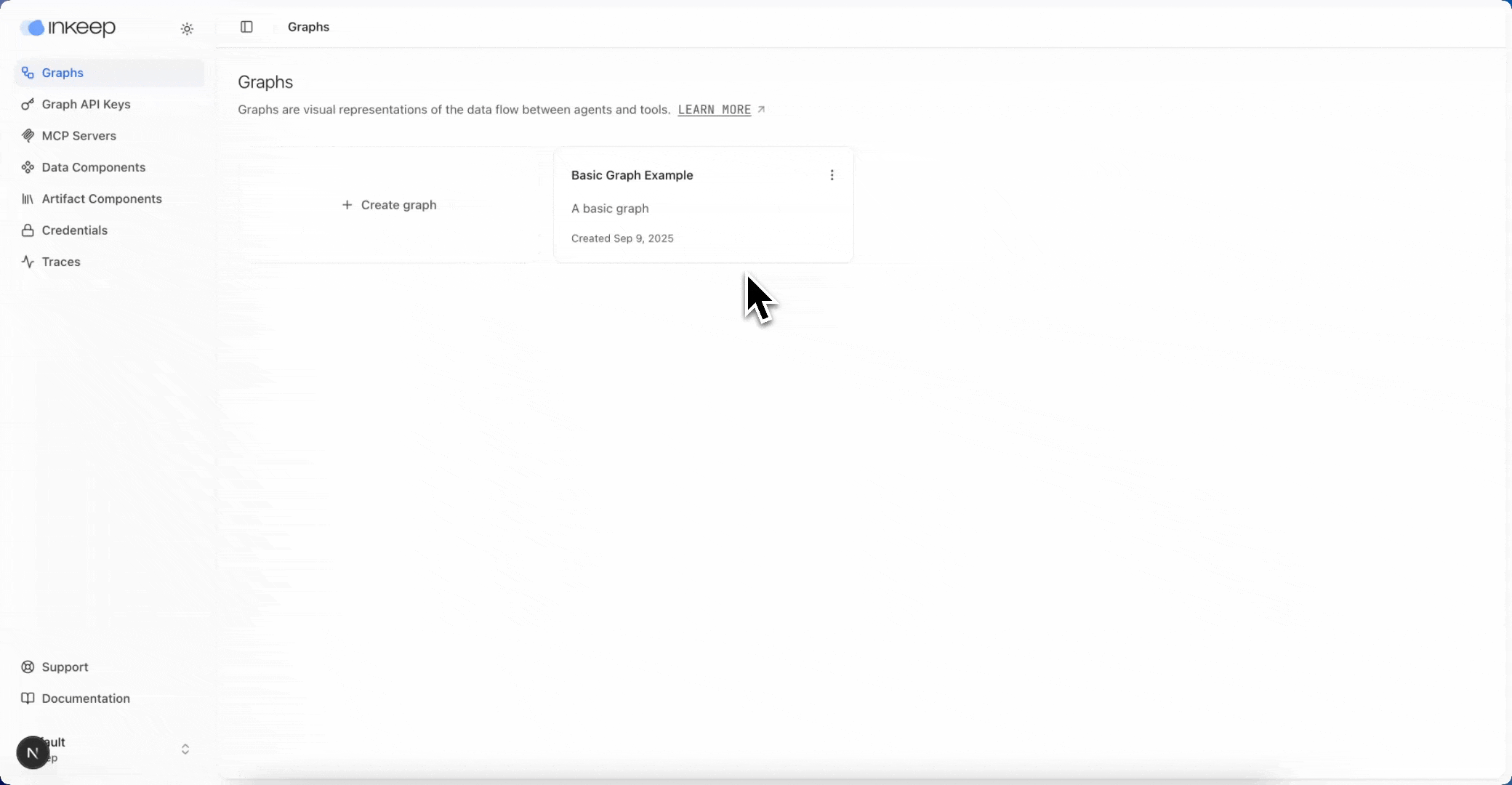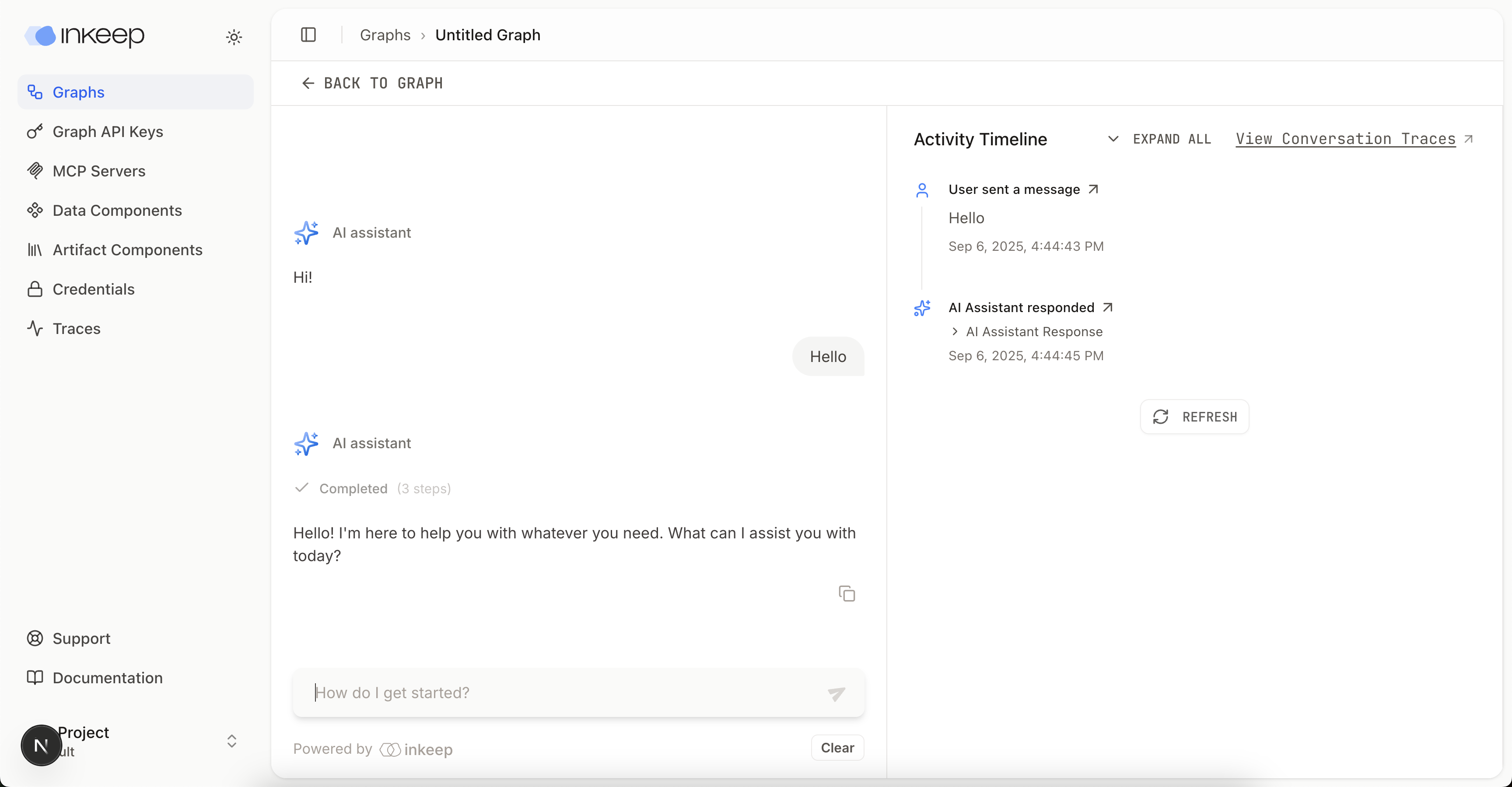Contribute to Inkeep Open Source project
Copy page
How to contribute to the Inkeep Agent Framework
Making a Contribution
Thank you for your interest in contributing to the Agent Framework! This document provides guidelines and information for contributors.
Launch the Visual Builder
Prerequisites
Before getting started, ensure you have the following installed on your system:
Step 1: Clone the repository
Step 2: Run the setup script
For first-time setup, run:
This will:
- Create
.envfrom the template - Set up user-global config at
~/.inkeep/config - Install dependencies
- Initialize the database, starting the postgres docker container and applying migrations
Add API keys for the AI providers you want to use to the root .env. You must have at least one AI provider configured.
Add your SigNoz API key to enable the traces feature (optional).
Add your Nango secret key to enable the Nango credential store (optional).
Step 5: Run the agent framework
Step 6: Start building!
Open http://localhost:3000 in the browser and start building agents.
Push your project
A key advantage of the Inkeep agent framework is its seamless code-to-visual workflow: define your agents programmatically, push them to the Visual Builder, and continue developing with the intuitive drag-and-drop interface.
Follow the steps below to push your project using the Inkeep CLI.
Step 1: Download the Inkeep CLI
Step 2: Push the project
The project will be pushed according to the project specified in the
/agents-cookbook/template-projects/inkeep.config.ts file, which is set to the default project by
default. Feel free to change it to your own project.
Step 3: Observe the Agent in the Visual Builder

Set up live traces
Step 1: Launch docker containers
Step 2: Fetch SigNoz API Key
Open http://localhost:3080 in the browser. Go to Settings → Workspace Settings → API Keys and copy the API key.
Step 3: Configure environment variable
Create a .env file at /agents-manage-ui/ with the following variable:
Step 4: View your live traces
Refresh the live traces panel on the right to see your agents in action.

Set up credentials
Step 1: Create .env file and generate encryption key
Step 2: Restart the containers
Step 3: Get your Nango API key
Open the Nango Dashboard: http://localhost:3050 and navigate to Environment Settings → API Keys and copy the API key.
Step 4: Configure environment variables
Navigate back to the root directory and paste the below command. Enter your Nango API key when prompted:
Step 5: Start creating credentials!
Navigate to the Credentials tab in the left sidebar and click "Create credential".
Development Workflow
Git Hooks
This project uses Husky for Git hooks to maintain code quality. The hooks are automatically installed when you run pnpm install.
Pre-commit Hook
The pre-commit hook runs the following checks before allowing a commit:
- Type checking - Ensures type safety across all packages
- Tests - Runs the test suite
Bypassing Checks
While we recommend running all checks, there are legitimate cases where you might need to bypass them:
Skip typecheck only (tests still run):
Skip all hooks (use sparingly):
Note: Use these bypass mechanisms sparingly. They're intended for:
- Work-in-progress commits that you'll fix before pushing
- Emergency fixes where speed is critical
- Commits that only touch non-code files (though hooks are smart enough to handle this)
Code Quality
Type Checking
Run type checking across all packages:
Linting
Run the linter:
Format code automatically:
Testing
Run tests:
Building
Build all packages:
CLI Development
Running the CLI Locally
When developing the CLI, you can run the local version directly without global installation:
Testing CLI Changes
- Build the CLI after making changes:
- Test commands locally:
- Run CLI tests:
Switching Between Local and Published CLI
During development, you may need to test both the local development version and the published npm package:
For detailed information about switching between versions, see the INKEEP_CLI_SWITCHING.md file in the repository root.
Commit Messages
We follow conventional commit format:
Types:
feat: New featurefix: Bug fixdocs: Documentation changesstyle: Code style changes (formatting, etc.)refactor: Code refactoringtest: Test changeschore: Build process or auxiliary tool changes
Pull Requests
- Fork the repository
- Create a feature branch (
git checkout -b feat/amazing-feature) - Make your changes
- Ensure all checks pass (
pnpm typecheck && pnpm test) - Commit your changes (following commit message guidelines)
- Push to your fork
- Open a pull request
PR Guidelines
- Keep PRs focused on a single feature or fix
- Update tests for any behavior changes
- Update documentation as needed
- Ensure CI passes before requesting review
Continuous Integration
Our CI pipeline runs on all pull requests and includes:
- Type checking (
pnpm typecheck) - Tests (
pnpm test) - Build verification (
pnpm build)
These checks must pass before a PR can be merged. The same checks run in pre-commit hooks to catch issues early.
Questions?
If you have questions about contributing, please:
- Check existing issues and discussions
- Open a new issue if your question isn't addressed
- Reach out to the maintainers
Thank you for contributing!